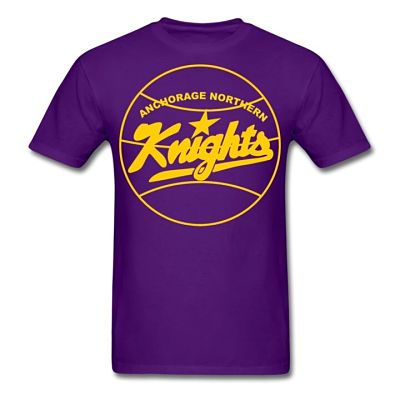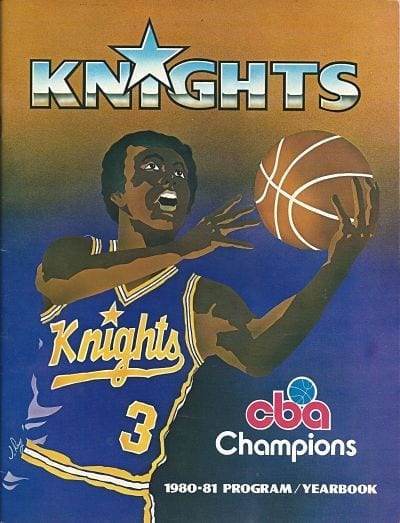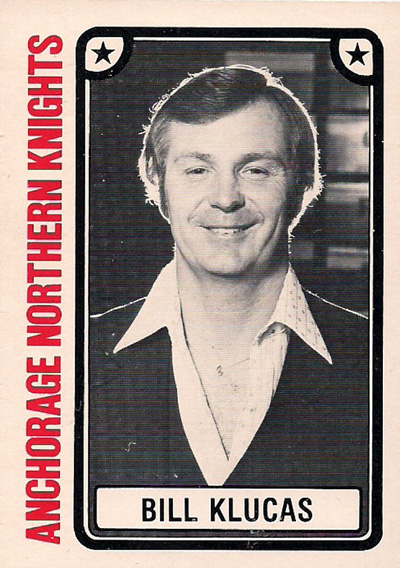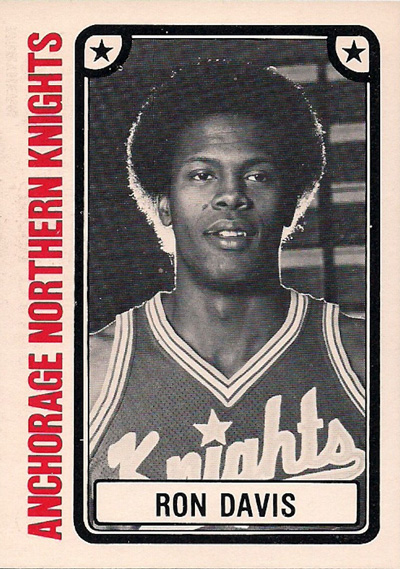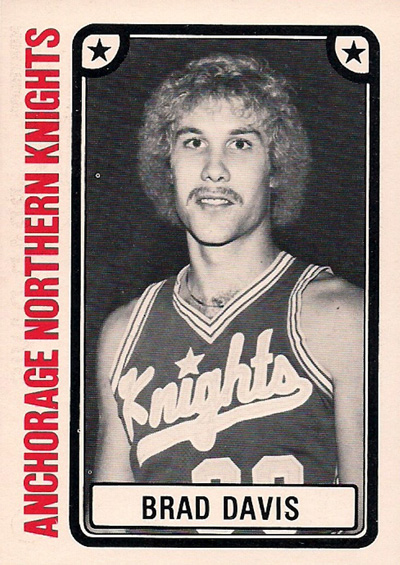Eastern Basketball Association (1977-1978)
Continental Basketball Association (1978-1982)
Tombstone
Born: September 26, 1977 – EBA expansion franchise1ASSOCIATED PRESS. “Anchorage cage team okayed”. The Daily News-Miner (Fairbanks, AK). September 27, 1977
Folded: July 26, 1982
First Game: November 19, 1977 (117-112 vs. Wilkes-Barre Barons)
Last Game: March 14, 1982 (L 130-119 @ Montana Golden Nuggets)
EBA Championships: None
CBA Champions: 1980
Arenas
Anchorage Civic Arena (4,024)21978-79 Continental Basketball Association Official Guide
Anchorage West High School (2,800)31980-81 Anchorage Northern Knights Yearbook
Marketing
Team Colors: Purple, White & Gold41980-81 Anchorage Northern Knights Yearbook
Ownership
Owners:
- 1977-1979: Rick Smith, et al.
- 1979-1980: Roger Jacobsen
- 1980-1982: Mike Shupe, Hal Thompson, Terry Miller & Dennis McFeron
Best Seller
We earn commissions from purchases made through links in this post
Anchorage Northern Knights Logo T-Shirt
Now Available at Rebound Vintage Hoops!
Background
Rick Smith’s resume isn’t much to look at. An Air Force brat whose family moved around the country, arriving in Alaska in 1961, two years after statehood and seven years before oil. He attended Anchorage West High School, then a little bit of college but never finished. Worked at putting in railroad ties and driving a truck for Union Oil. Managed a bicycle shop in Anchorage for a while in the 1970’s. It’s not the traditional curriculum vitae you might expect for the man who introduced professional sports to Alaska. Or, for that matter, a corporate Vice President of Government Affairs at the center of a corruption scandal that brought down several state representatives and the longest serving Republican Senator in the history of the U.S. Congress. But Rick Smith is both of those things and maybe that’s because his story took place not in Manhattan or Silicon Valley or Washington, D.C., but in boomtown Alaska when crude oil flowed out of the Earth and later spilled into the sea and there was big money to be made in either circumstance.
The basketball scheme started in the bike shop. Or rather The Bicyle Shop, the popular Schwinn dealership where Smith worked as a manager for his high school friend Mike Shupe. The year was 1977. The Trans-Alaska Pipeline opened up to start pumping that precious oil discovered in Prudhoe Bay nine years earlier down to the port of Valdez. The population of Anchorage had doubled in the intervening decade, primed by oil and aviation. Anchorage, Smith felt, was ready for its own pro sports franchise, specifically a basketball team.
Re-Making The Eastern Basketball Association
Trouble was there was no minor league basketball on the West Coast of the United States. And even if there had been, would it have mattered? The closest major Western city – Seattle – was nearly 2,400 miles away. Seattle is closer to Detroit, Michigan than it is to Anchorage. In fact, there was only one league still playing minor league hoops in the late 1970’s. The Eastern Basketball Association had been plugging away in the armories and Catholic youth halls of industrial towns in Pennsylvania, New Jersey and New York since 1946. Naturally, Smith and his cohorts decided to apply for an Eastern Basketball Association expansion franchise. After all, as Smith liked to point out, Alaska is not only the Westernmost point in the the United States, but it is also the Easternmost point in the country, straddling the 180th meridian as it does.
Suspending their disbelief – and sensing a rare opportunity for publicity – the existing EBA owners voted to admit Smith’s Anchorage Northern Knights in mid-September 1977 for the modest sum of $8,000. The Northern Knights closest geographic rival would be the Allentown (PA) Jets, a mere 4,400 miles away. The bizarre arrangement required some financial and logistical gymnastics. The Northern Knights would play 21 of their 31 games at home, including the first 16 in a row. They would pay the airfare and lodging for all of their opponents in Anchorage and would play baseball-style homestands, facing each club two or three times during the course of each rival’s annual visit to Alaska. The Northern Knights themselves would take just one annual road trip, swinging through the other nine EBA cities on one marathon stretch in the middle of the season. The Knights anticipated an annual expense budget of $300,000 due to the travel requirements, a figure which dwarfed the planned $110,000 budget of the EBA’s Long Island Ducks expansion team and the $35,000 it would take to operate the league’s oldest franchise, the Allentown Jets.
Debut
The Northern Knights set up shop at West High School, alma mater of Smith and his boss/co-investor Mike Shupe. The 4,000 gymnasium was the largest arena in Anchorage at the time. The gym sold out for the Knights’ November 1977 debut against the Wilkes-Barre (PA) Barons. The goofy circumstances attracted Sports Illustrated writer John Papanek, who was on hand to witness the Knights and Barons shatter both backboards while showboating during pre-game warm ups. After a two-hour plus delay to scour Anchorage for spare backboards, pro basketball finally made its debut in Alaska, albeit with an impromptu “no dunking” rule in force for the first game.
Under Head Coach Bill Klucas, the Northern Knights put together the best regular season record (24-7) in the EBA in 1977-78, before falling in the playoff semi-final to the Lancaster (PA) Red Roses. The Knights were also a hit at the box office, averaging over 2,000 fans per game, in a league where the average draw was approximately 750. Nevertheless, the travel expenses were a substantial and unique burden and the Knights lost a reported $100,000 during their first season – more than the entire expense budget of many of the less popular Eastern clubs.
The Knights returned under Smith’s direction in November of 1978. Emboldened by the addition of Anchorage and the resulting national attention, the sleepy Eastern Basketball Association had re-branded itself for the 1978-79 season as the rather more grand Continental Basketball Association. Klucas’ Knights were strong again, posting a 24-12 record and advancing to the CBA Championship series, where the Rochester Zeniths swept them in four games.
Championship Season
The Knights finally put it all together in their third season in the winter of 1979-80. Guard Brad Davis, a disappointment to the Los Angeles Lakers as their first round pick in 1977, revitalized his career in Anchorage while helping to lead the Knights back to the CBA Championship Series. Forward Ron Davis (no relation) earned CBA Most Valuable Player honors. The Northern Knights avenged their 1979 finals loss to Rochester, taking the Zeniths to the series limit before finishing them off with a 109-99 victory in the seventh and deciding game.
By the time the Knights’ fourth season kicked off in the winter of 1980, the novelty factor was long gone. The wacky Knights who endured 5,000 mile road trips to play in a “nickel and dime Pennsylvania mill-town circuit”, in the words of Sports Illustrated‘s Papanek, were now just another member of the Continental Basketball Association’s Western Division. They had new and (relatively) proximate rivals in burgs like Lethbridge, Alberta and Billings and Great Falls, Montana. Now that the CBA was truly national, the Knights no longer needed to play unbalanced schedules or take month-long road trips. Local enthusiasm for the Knights faded along with the notoriety. The club’s second home game of 1980 drew an all-time record low of just 270 fans to West High School. The Knights tried to inject some enthusiasm by signing Don “Slick” Watts, a cult hero to Seattle Supersonics fans of the 1970’s. But the 29-year old didn’t care for Anchorage and left the team after less than two weeks.
Financial Problems & Demise
The Knights changed hands several times, shuffling among various members of Rick Smith’s group of 75 or so investors who put up the original $40,000 to launch the club in 1977. The Knights reportedly lost $250,000 during their first two seasons before Smith and his primary partners handed the keys to Roger Jacobsen, a minor original investor and Knights season ticket holder, who became the new sole owner in October 1979. Jacobsen lost $200,000 in one year at the helm. Less than a year later, the Knights were in the hands of a new group headed by Mike Shupe, another original investor and Smith’s old boss at The Bicycle Shop.
The club was non-competitive in its final season in the winter of 1981-82, finishing in last place with a 14-32 record. The Northern Knights played their final game in March 1982 and folded later that summer.
Aftermath
After winning a CBA title in Anchorage in the spring of 1980, guard Brad Davis joined the NBA’s expansion Dallas Mavericks for the 1980-81 season. Davis went on to spend 12 seasons with the Mavs. During his final season of 1991-92, he became the first player to have his number retired by the franchise.
Ron Davis, the 1979-80 CBA MVP, got back to the NBA with the San Diego Clippers. Davis played in 64 games during the 1980-81 season.
Northern Knight Tico Brown went on to play 10 seasons in the CBA, retiring in 1988 as the league’s all-time leading scorer with 8,538 points. He never played in the NBA.
Anchorage Northern Knights Shop
[auction-nudge tool=”listings”]
Downloads
1980-81 Northern Knights Ticket Brochure
1980-81 Anchorage Northern Knights Ticket Brochure
Links
###


